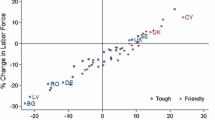Summary
The demo-economic multiplier which we used in our computations, is a measure for the influence of the demographic pattern on the economy. In the first part of our paper the demo-economic multiplier is derived, which indicates the total (direct and indirect) deliveries of the sectors of the economy for the different types of households.
The following section is devoted to an evaluation of the impact of the population size and structure on the economy. To achieve this, we use a rate of sensitivity which is defined on a special matrix norm.
The derived demo-economic multiplier is added to a multisectoral model of the Austrian economy MUSEM A78. The main conclusion of our computation is the fact that a change in the demographic pattern shows only little effect on the overall economic development. The structural effect, however, is significant and would certainly be more interesting, if more disaggregated data could be used.
Similar content being viewed by others
References
Björck, D., andG. Dahlquist: Numerische Methoden. München-Wien 1972.
Coal, A.J. (Ed.): Economic Factors in Population Growth, Proceedings of a Conference held by the International Economic Association at Valescure, 1976.
Forsythe, G.E., andC.B. Moler: Computer Solution of Linear Algebraic Systems. Pentice-Hall 1967.
Luptačik, M.: Zur EinschÄtzung ökonomischer Auswirkungen demographischer Prozesse. StationÄre und schrumpfende Bevölkerungen. Demographisches Null- und Negativwachstum in österreich. Hrsg. v. G. Feichtinger. Lecture Notes in Economics and Mathematical Systems. Berlin 1977, 209–236.
österreichisches Statistisches Zentralamt: Konsumerhebung 1974. Wien 1976.
Schinnar, A.P.: Eco-demographic models for planning and forecasting. School of Public and Urban Policy. University of Pennsylvania, 1974, October 1976.
: An eco-demographic accounting-type multiplier analysis of Hungary. Environment and Planning.9, 1977, 373–384.
Schmoranz, I.: Ein multisektorales Modell für österreich MUSEM A78. Internal Discussion Paper of the Institute for Advances Studies. Vienna 1978 (unpublished).
Schultz, T.W. (Ed.): Economics of the Family. Marriage, Children, and Human Capital. A Conference Report of the National Bureau of Economic Research. Chicago 1974.
Skolka, J.: Anwendung der Input-Output-Analyse. Berechnungen am Beispiel der österreichischen Wirtschaftsstruktur. Wien 1974.
Turnovec, F.: Global and Local Sensitivity Analysis in an Open Leontief Input-Output System. Mathematische Optimierungstheorie und ihre Anwendungen. Intern. Wiss. Kollequim, TH Illmenau, 1976.
Author information
Authors and Affiliations
Additional information
We have to thank G. Orosel, P. Mitter and U. Schubert for valuable discussions as well as by two anonymous referees for interesting comments.
Rights and permissions
About this article
Cite this article
Luptačik, M., Schmoranz, I. Demographic changes and economic consequences: Demo-economic multiplier for Austria. Empirical Economics 5, 55–67 (1980). https://doi.org/10.1007/BF01848043
Received:
Revised:
Issue Date:
DOI: https://doi.org/10.1007/BF01848043



